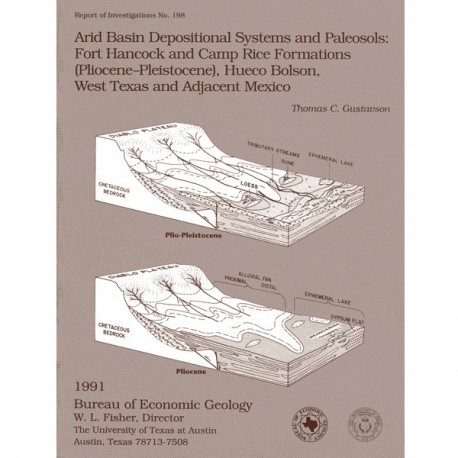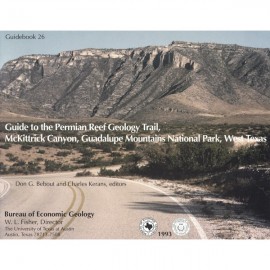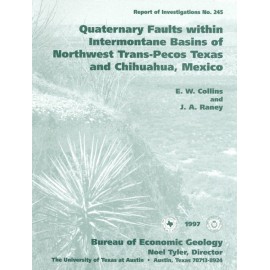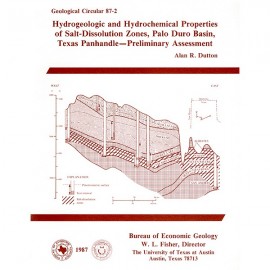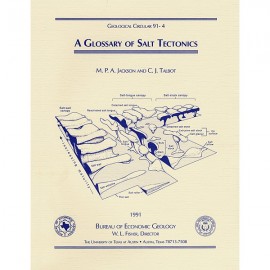Reports of Investigations
-
Books & Reports
- Reports of Investigations
- Guidebooks
- Udden Series
- Geological Circulars
- Down To Earth
- Atlases of Major Oil and Gas Reservoirs
- Texas Memorial Museum Publications
- Environmental Geologic Atlas of the Texas Coastal Zone
- Mineral Resource Circulars
- Other Reports
- Seminars and Workshops
- Handbooks
- Submerged Lands of Texas
- Symposia
- Annual Reports
- Open File Reports
-
Maps & Cross Sections
- Thematic Maps
- Miscellaneous Maps, Charts & Sections
- Geologic Atlas of Texas
- STATEMAP Project Maps
- Geologic Quadrangle Maps
- Cross Sections
- Highway Geology Map
- Energy and Mineral Resource Maps
- Shoreline Change and Other Posters
- Wilcox Group, East Texas, Geological / Hydrological Folios
- Bouguer Gravity Atlas of Texas
- River Basin Regional Studies
- Featured Maps
- Posters
- Teachers & the Public
-
Geological Society Publications
- Gulf Coast Association of Geological Societies
- Alabama Geological Society
- Austin Geological Society
- Corpus Christi Geological Society
- Houston Geological Society
- Lafayette Geological Society
- Mississippi Geological Society
- New Orleans Geological Society
- South Texas Geological Society
- GCS SEPM Publications
- Historic BEG & UT Series
Arid Basin Depositional Systems and Paleosols: Fort Hancock and Camp Rice Formations, Hueco Bolson...and Adjacent Mexico
RI0198
For a downloadable, digital version: RI0198D.
RI0198. Arid Basin Depositional Systems and Paleosols: Fort Hancock and Camp Rice Formations (Pliocene-Pleistocene), Hueco Bolson, West Texas and Adjacent Mexico, by T. C. Gustavson. 49 p., 29 figs., 3 tables, 1 appendix, 1991. ISSN: 0082335X: Print.
To purchase this publication as a downloadable PDF, please order RI0198D.
ABSTRACT
The Hueco Bolson is a segment of the Rio Grande Rift that formed as a result of late Tertiary Basin and Range deformation. The upper Tertiary Fort Hancock Formation and the upper Tertiary-Quaternary Camp Rice Formation compose the basin fill except in the deepest (western) parts of the bolson.
Five lithofacies form the Fort Hancock Formation: (I) gravel; (II) sand, sandy mud or sandy silt, and gravel; (III) sand, sandy mud, and sandy silt; (IV) clay and sandy clay; and (V) clay, mud, sandy mud, and gypsum. These lithofacies represent the textural gradation from basin margin to basin center of proximal to transitional to distal alluvial fans (lithofacies I through III) to ephemeral lakes (N) to saline playas 0. In cores from the study area, these samelithofacies compose a 230-m-thick (700-ft) upward-fining sequence. The sequence records the lacustrine expansion that occurred over basin-margin alluvial fans as the basin filled.
The Fort Hancock Formation is separated from the overlying Camp Rice Formation by a regional unconformity. This unconformity records a period of extensive erosion marking the integration of the ancestral southern and northern segments of the Rio Grande about 2.25 Ma ago. Fluvial, lacustrine, and eolian sediments formed above the unconformity as the Camp Rice Formation. Five lithofacies also constitute the Camp Rice Formation: (1) sand and locally derived gravel, deposited by tributaries of the Rio Grande; (2) sand and exotic gravel, derived from north of the study area and deposited by a through-flowing stream (the Rio Grande); (3) sand, deposited as a dune complex; (4) coarse silt and very fine sand, deposited as loess; and (5) clay, sandy clay, and gypsum, deposited in ephemeral lakes with central playas.
Paleoclimatic conditions can be inferred from both buried soils and depositional environments. Numerous Stage I and Stage I1 calcic soils exist in the Fort Hancock and Camp Rice Formations, indicating that while these sediments were being deposited the climate was most likely arid to subhumid. Clayey and muddy facies with locally preserved bedded gypsum, interpreted as ephemeral lake and saline playa deposits, are present in both formations. These depositional environments also suggest an arid to semiarid climate.
Paleovertisols, which formed primarily from repeated episodes of expansion and contraction of lacustrine muds and clays caused by precipitation or flooding and desiccation, are common in outcrops and in cores of smectite-rich clay and mud facies of the Fort Hancock and Camp Rice Formations.
Keywords: alluvial fan, Camp Rice Formation, ephemeral lake, Fort Hancock Formation, geomorphology, Paleocene, paleoclimate, paleosols, Pleistocene, stratigraphy, Vertisols
CONTENTS
Abstract
Introduction
Geologic Setting
Tectonic History
Physical and Genetic Stratigraphy
Age of the Fort Hancock and Camp Rice Formations
Physiographic Evolution
Paleosols
Methods
Fort Hancock Formation
Gravel Lithofacies
Description
Interpretation
Sand, Sandy Mud or Sandy Silt, and Gravel Lithofacies
Description
Interpretation
Sand, Sandy Mud, and Sandy Silt Lithofacies
Description
Interpretation
Clay and Sandy Clay Lithofacies
Description
Interpretation
Clay, Mud, Sandy Mud, and Gypsum Lithofacies
Description
Interpretation
Sources of Fort Hancock Sediment Paleoclimate
Rates of Deposition
Depositional History
Fort Hancock- Camp Rice Unconformity and the Integration of Rio Grande Drainage
Fort Hancock-Camp Rice Unconformity
Ages of the Fort Hancock-Camp Rice Unconformity and the Integration of Rio Grande Drainage
Camp Rice Formation
Sand and Gravel Lithofacies (with Common Locally Derived Lithoclasts)
Description
Interpretation
Sand and Exotic Gravel Lithofacies
Description
Interpretation
Sand Lithofacies
Description
Interpretation
Coarse Silt and Very Fine Sand Lithofacies
Description InterpretationClay, Sandy Clay, and Gypsum Lithofacies
Description Interpretation
Depositional History
Paleoclimate
Paleovertisols
Vertisol Characteristics
Paleovertisol Properties
Structures in Paleovertisols
Models for Vertisol Pedogenesis
Pedoturbation
Differential Loading
Soil Mechanics
Degree of Buried Vertisol Development
Age of Paleovertisols
Summary
Acknowledgments
References
Appendix: Structural Cross Section of Upper Tertiary- Quaternary Strata, Northeastern Flank, Hueco Bolson, West Texas
Figures
1. Location map showing described sections
2. Stratigraphic correlation chart, south-central New Mexico and Hueco Bolson, Texas
3. Lithologic diagram interpreted from core of Texas Low-Level Radioactive Waste Disposal Authority well
4. Matrix-supported. subangular limestone gravel in well core and coarse, crudely bedded conglomerate of Fort Hancock Formation, exposed at head of an alluvial fan adjacent to mountain front
5. Stratigraphic section, upper Fort Hancock Formation, exposed in headwaters of Alamo Arroyo
6. Stratigraphic section, upper Fort Hancock Formation and Camp Rice Formation, exposed in Diablo Arroyo (base of section = 1,137 m)
7. Stratigraphic section, upper Fort Hancock Formation and Camp Rice Formation, exposed in Diablo Arroyo (base of section = 1,177 rn)
8. Stratigraphic section, upper Fort Hancock Formation, northeast of type section of Fort Hancock Formation in Madden Arroyo
9. Ripple cross-laminated, silty, very fine sand from core of Texas Low-Level Radioactive Waste Disposal Authority well 22
10. View of upper Tertiary Fort Hancock Formation overlain unconformably by Quaternary Madden Gravel in headwaters of Alamo Arroyo
11. Textural classifications of sediments of Fort Hancock and Camp Rice Formations
12. X-ray diffraction diagram of selected samples of Fort Hancock Formation clay and mud facies
13. Interbedded clay and gypsum of the clay, mud, sandy mud, and gypsum lithofacies of Fort Hancock Formation
14. Stratigraphic section, upper Fort Hancock Formation, exposed in Nealy Canyon
15. Stratigraphic section, upper Fort Hancock Formation, exposed in Quitman Canyon
16. Block diagram showing interpreted depositional environments of Fort Hancock Formation, southern Hueco Bolson
17. Large-scale trough cross-stratification in sand and gravel lithofacies of Camp Rice Formation
18. Lithoclasts including a large mud ball in the Camp Rice Formation derived from clayey facies of Fort Hancock Formation
19. Stratigraphic section, Fort Hancock and Camp Rice Formations, exposed along Alamo Arroyo
20. Block diagram showing interpreted depositional environments and lithofacies of Camp Rice Formation, southern Hueco Bolson
21. Scanning electron microscope image showing microstructure of smectite clays
22. Photomosaic of a paleovertisol developed in sandy clay of Fort Hancock Formation
23. Model illustrating vertical distribution of characteristic soil structures of buried Vertisols in Fort Hancock and Camp Rice Formations
24. Surface exposure of a mulch or nut zone
25. Plan view of desiccation cracks in block of moderate-gray Fort Hancock Formation sandy clay
26. CaCO3-cemented sandy silt fills desiccation cracks in a buried Vertisol, Fort Hancock Formation
27. Slickensides on a blocky soil aggregate from a buried Vertisol, -upward fracture surfaces with slickensides, Fort Hancock Formation
28. Large wedge-shaped soil aggregate bounded by s lightly concave-upward fracture surfaces with slickensides, Fort Hancock Formation
29. Scanning electron microscope image of edge and surface of slickensides developed on a fragment of soil aggregate from a buried Vertisol, Fort Hancock Formation
Tables
1. Fort Hancock Formation lithologies and interpreted depositional environments
2. Soil characteristics of modern Vertisols and paleovertisols of Fort Hancock and Camp Rice Formations. Hueco Bolson
3. Camp Rice Formation lithofacies and interpreted depositional environments
Citation
Gustavson, T. C., 1991, Arid Basin Depositional Systems and Paleosols: Fort Hancock and Camp Rice Formations (Pliocene-Pleistocene), Hueco Bolson, West Texas and Adjacent Mexico: The University of Texas at Austin, Bureau of Economic Geology, Report of Investigations No. 198, 49 p.
